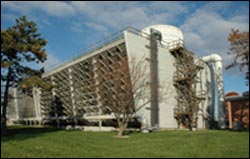Additives may save energy for cooling big buildings

NIST laboratory experiments have demonstrated that adding small amount of additives to refrigerants may significantly improve the efficiency of commercial air conditioning.
A National Institute of Standards and Technology (NIST) researcher has come up with a method designed to improve the energy efficiency of water chillers that cool the nation’s large commercial buildings. The NIST method, if confirmed through experiments with full-scale chiller systems, could save as much as 1 percent of the 320 billion kWh of electricity used annually by chillers or an equivalent 920,000 barrels of oil a day, according to Mark Kedzierski, the NIST mechanical engineer who developed the technique.
The advance builds on past NIST research designed to optimize mixtures of chiller refrigerants with lubricants. The researchers discovered that some lubricants, when injected in small amounts, can significantly enhance evaporator heat transfer, increasing the efficiency of chillers. When they studied the process more closely they found the most efficient heat transfer occurred when the added oil’s surface tension, viscosity, composition and chemical characteristics complemented those of the chiller’s base lubricant.
In a recent paper* describing the method, Kedzierski describes how the right additive forms a very thin covering on an evaporator surface, which produces enhanced bubbling during boiling. The improved conversion of the refrigerant molecules into vapor molecules increases the chiller’s cooling capacity similar to a heat pump.
Kedzierski developed rules for the selection of the different types of oil additives according to the type of chiller lubricant, making successful energy enhancement less of a hit-or-miss proposition. Laboratory work is under way testing the energy enhancing potential of several oil and lubricant combinations that have been identified by the rules.
“The leap from a successful laboratory experiment to an everyday large-scale cooling application is a big one. NIST wants to see this theory translated into products germane to manufacturers as soon as possible,” Kedzierski said. “We welcome private-sector interest in the theory and its application.”
*M. Kedzierski. Method and transport properties for enhancing the nucleative heat transfer of refrigerant chiller evaporators. PriorArt Database, ip.com. Online publication date, Sept. 28, 2005. The NIST theory and research is also described at http://www.bfrl.nist.gov/pdf/NISTIR7132.pdf.
Media Contact
More Information:
http://www.bfrl.nist.gov/pdf/NISTIR7132.pdfAll latest news from the category: Power and Electrical Engineering
This topic covers issues related to energy generation, conversion, transportation and consumption and how the industry is addressing the challenge of energy efficiency in general.
innovations-report provides in-depth and informative reports and articles on subjects ranging from wind energy, fuel cell technology, solar energy, geothermal energy, petroleum, gas, nuclear engineering, alternative energy and energy efficiency to fusion, hydrogen and superconductor technologies.
Newest articles

Parallel Paths: Understanding Malaria Resistance in Chimpanzees and Humans
The closest relatives of humans adapt genetically to habitats and infections Survival of the Fittest: Genetic Adaptations Uncovered in Chimpanzees Görlitz, 10.01.2025. Chimpanzees have genetic adaptations that help them survive…

You are What You Eat—Stanford Study Links Fiber to Anti-Cancer Gene Modulation
The Fiber Gap: A Growing Concern in American Diets Fiber is well known to be an important part of a healthy diet, yet less than 10% of Americans eat the minimum recommended…

Trust Your Gut—RNA-Protein Discovery for Better Immunity
HIRI researchers uncover control mechanisms of polysaccharide utilization in Bacteroides thetaiotaomicron. Researchers at the Helmholtz Institute for RNA-based Infection Research (HIRI) and the Julius-Maximilians-Universität (JMU) in Würzburg have identified a…



